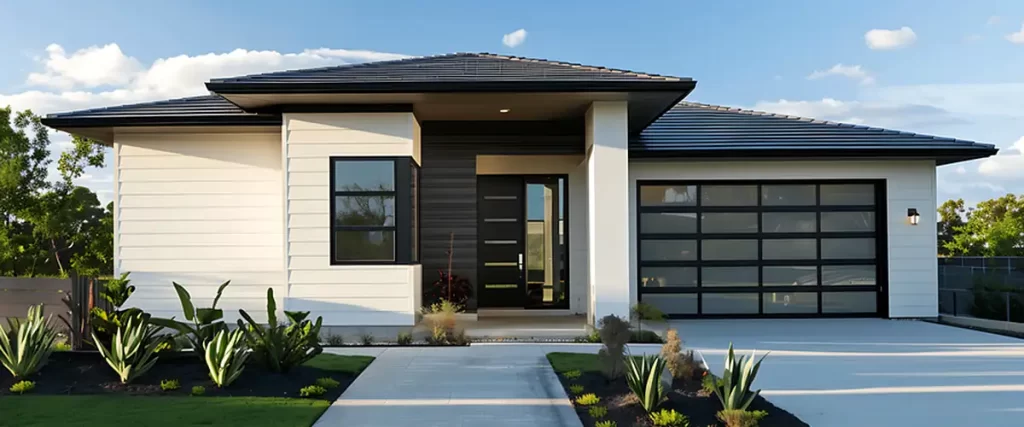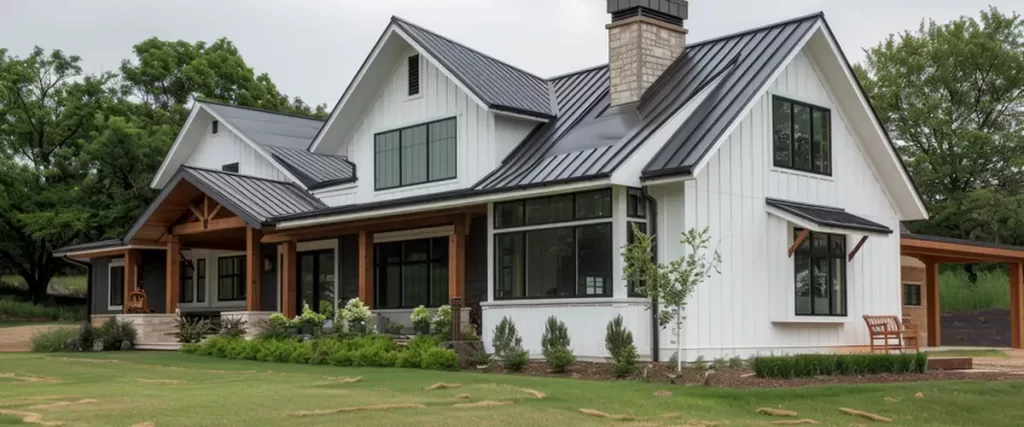James Hardie siding is one of the most popular choices for homeowners looking for lasting curb appeal, durability, and a material that holds up in extreme weather. But while the value is clear, many people ask the same question before starting a project: how much does James Hardie siding cost?
There’s no single price tag that fits every home. The total cost per square foot depends on your home’s size, the product line you choose, and how complex the installation is.
Average Cost of James Hardie Siding
The average total cost to install James Hardie siding, materials and labor included, typically ranges from $10 to $15 per square foot. That means most homeowners spend between $20,000 and $30,000 on a full siding replacement for a home with about 2,000 square feet of exterior wall surface.
The range is wide because of variations in home designs, the condition of your current siding, and trim details.
Material Costs
Hardie board siding materials alone typically cost $2.50 to $5.00 per square foot, depending on the product line and style. Lap siding is the most common, but there are also panel styles, shingles, and vertical boards, all at different price points.
Labor Costs
Professional installation adds about $7 to $10 per square foot. This is higher than labor costs for vinyl or aluminum siding due to the tools, time, and skill required. Fiber cement products are heavy, and installing them correctly takes more effort.

What Impacts the Total Cost?
Several key factors determine how much your James Hardie siding project will cost from start to finish. Some are predictable, others might surprise you.
1. Size and Design of the Home
Larger homes need more siding, but surface area isn’t the only factor. Houses with complex rooflines, multiple levels, or detailed architectural features often involve additional labor, more cuts, and extra trim. These elements increase installation time and material usage, which can raise the overall cost.
2. Siding Removal
If you have old siding that must be removed before installation begins, expect additional labor costs. This includes disposal fees, handling damaged areas, or repairing sheathing behind your current siding. Removal alone can add $1,000 to $3,000.
3. Trim and Accessories
James Hardie siding includes more than wall panels. A complete installation typically involves:
- Corner boards
- Window and door trim
- Soffits and fascia
- Starter strips and joint covers
These pieces protect your home’s exterior and tie the design together, but they also increase material and labor costs.
4. Local Labor Rates
Labor costs vary depending on your area. In places with a high demand for skilled siding contractors or a busy construction season, installation costs may rise. That’s why working with experienced local crews who specialize in Hardie board installation can save money in the long run.
5. Permit Fees and Regional Requirements
Depending on your location, your siding project may require city permits or inspections. While these aren’t typically expensive, they’re worth including in your budget.
Is James Hardie Siding Worth the Investment?
Many homeowners are drawn to James Hardie for its long lifespan and performance. Though it has a higher upfront cost, the long-term value can outweigh that initial expense.
Durability and Lifespan
Hardie board siding is made from fiber cement, a mixture of cement, sand, and cellulose fibers. It’s known for resisting:
- Warping and cracking
- Moisture infiltration
- Insects and pests
- Fire and heat
When installed correctly, it can last 30 to 50 years, often outlasting other siding materials.
Low Maintenance
Unlike wood siding, fiber cement doesn’t need frequent painting, sealing, or staining. James Hardie’s ColorPlus® finish resists UV damage and typically holds color longer than field-applied paint, lowering long-term maintenance costs.
Aesthetic Appeal
Hardie siding closely mimics the look of wood grain, without the vulnerabilities that come with it. Whether you’re going for a modern farmhouse style or a more traditional exterior, the design options are broad.
Popular styles include:
- Lap siding (also known as HardiePlank)
- Vertical siding
- Shingle-style panels
- Board and batten configurations
These choices allow homeowners to match the architectural style of their house while improving curb appeal.
Fire Resistance
Fiber cement siding is non-combustible, which can be a significant advantage for homeowners living near wildfire-prone areas or with outdoor heat sources like fire pits or grills. It may also help reduce home insurance premiums in some cases.
Comparing Costs with Other Siding Options
It’s helpful to see how Hardie board stacks up against other common materials in terms of both cost and performance.
| Siding Material | Installed Cost (Per Sq Ft) | Lifespan | Maintenance Level |
| James Hardie (Fiber Cement) | $10 – $15 | 30–50 years | Low |
| Vinyl | $6 – $11 | 20–40 years | Low |
| Wood | $8 – $14 | 15–25 years | High |
| Engineered Wood | $9 – $16 | 20–30 years | Moderate |
| Aluminum | $7 – $12 | 20–30 years | Moderate |
Hardie board isn’t the cheapest, but it provides a balance of longevity, style, and resilience that many homeowners find worthwhile.
Additional Costs to Plan For
When planning a fiber cement siding installation, don’t forget to factor in costs beyond panels and labor.
You may encounter:
- Repairs to existing wall sheathing
- Weather resistant barrier installation
- Custom painting or caulking
- Specialty trim pieces
- Scaffolding or specialty equipment
Not every home will need these, but it’s helpful to ask your contractor what’s included in their estimate.
How to Control Your Costs
There are a few ways to reduce costs without compromising the quality of your siding project:
- Limit decorative trim to the front of the home or high-visibility areas
- Choose standard siding styles instead of premium or specialty products
- Avoid last-minute upgrades during installation that may add labor time
- Plan your project during slower seasons, if scheduling allows
Working with contractors who regularly handle James Hardie siding installation can also help reduce waste and install time, keeping labor expenses more predictable.
The Importance of Professional Installation
Installing Hardie board requires more than general siding experience. Because the material is heavier and harder to cut, installers need special tools, training, and an understanding of fiber cement best practices.
Improper installation can lead to:
- Water damage
- Warped panels
- Unsealed seams
- Shortened product lifespan
Choosing a qualified crew with experience in fiber cement siding ensures your warranty remains valid and your siding performs as expected for decades.

Or Maybe You’d Rather Leave It to Us
There’s a lot to think through. Measurements, product choices, trim details, removal of old materials, underlayment, and the actual siding installation, it all adds up quickly. The price covers more than just panels. It reflects the care and experience required to do the job correctly, so the siding performs well and lasts for decades.
If you’d rather talk to someone who can handle the details and explain exactly what your home needs, we’re here for you.
Call us at (402) 651-1493 or Contact us. We’ll help you figure out if James Hardie siding is the right choice for your home and install it the right way.
